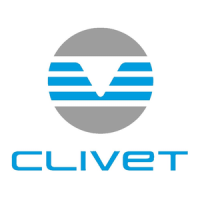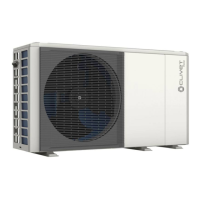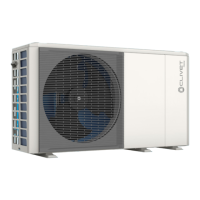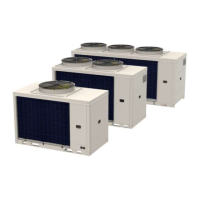41
Water connections
Ethylene glycol table
MIN outdoor
temperature
Glycol
concentration
Correction factors
Cooling capacity Power input Water resistance Water flow
0 °C 0% 1 1 1 1
-5 °C 10% 0.984 0.998 1.118 1.019
-15 °C 20% 0.973 0.995 1.268 1.051
-25 °C 30% 0.965 0.992 1.482 1.092
Table for propylene glycol
MIN outdoor
temperature
Glycol
concentration
Correction factors
Cooling capacity Power input Water resistance Water flow
0 °C 0% 1 1 1 1
-4 °C 10% 0.976 0.996 1.071 1
-12 °C 20% 0.961 0.992 1.189 1.016
-20 °C 30% 0.948 0.988 1.380 1.034
L
NOTE
Depending on the type of glycol selected, the concentrations may dier from the values in the tables.
Always compare these requirements with the glycol supplier’s specifications and use the actual specification
values of the product used. The glycol concentration must never be > 30%.
W
CAUTION
Glycol is a toxic fluid and should not be discharged freely: it must be collected and possibly reused. It must
contain inhibitors so that it does not become acidic in contact with oxygen: in the presence of copper and at
high temperatures this happens quickly.
Uninhibited acid glycol attacks metal surfaces and forms galvanic corrosion cells that cause severe damage
to the system.
Carefully check that:
– the glycol is compatible with the materials used in the system;
– water treatment is carried out correctly by a qualified specialist;
– the glycol chosen has corrosion inhibitors to counteract the acids formed by oxidation;
– only propylene glycol is used in installations with Domestic Hot Water tanks;
– no automotive glycol is used (corrosion inhibitors have a limited lifespan and contain silicates that can
damage or clog the system);
– galvanised pipes are not used in glycol systems, as they can cause certain components of the glycol
corrosion inhibitors to break down;
– no mixtures of dierent types of glycol (e.g. ethylene and propylene) are used.
L
NOTE
Glycol absorbs humidity from its environment, reducing its concentration. If glycol is used, duct the pressure
relief valve in accordance with the regulations in force, taking into account its toxicity and associated risks.
Avoid exposing glycol to air as much as possible and do not use glycol that has been exposed (e.g. glycol
container left open), it may not adequately protect against freezing.

